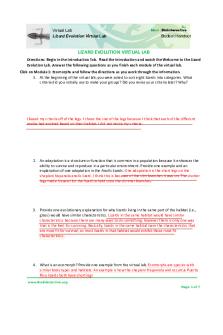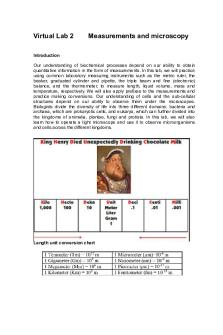Lizard Evolution Virtual Lab Student Worksheet PDF

| Title | Lizard Evolution Virtual Lab Student Worksheet |
|---|---|
| Course | Principles of Biology |
| Institution | Kansas State University |
| Pages | 5 |
| File Size | 365 KB |
| File Type | |
| Total Downloads | 78 |
| Total Views | 135 |
Summary
Download Lizard Evolution Virtual Lab Student Worksheet PDF
Description
Virtual Lab Lizard Evolution Virtual Lab
Student Handout
LIZARD EVOLUTION VIRTUAL LAB Answer the following questions as you finish each module of the virtual lab or as a final assessment after completing the entire virtual lab. Module 1: Ecomorphs 1. At the beginning of the virtual lab, you were asked to sort eight lizards into categories. What criteria did you initially use to make your groups? Did you revise your criteria later? Why? I sorted the 8 lizards into 3 color groups. The 23color groups i made are green, gray, and brown. I did change my labeling later by changing it to short legs and long legs! The leg size is a huge deciding factor with where they live.
2. An adaptation is a structure or function that is common in a population because it enhances the ability to survive and reproduce in a particular environment. Provide one example and an explanation of one adaptation in the Anolis lizards. The Anolis lizard adapted to have large toe pads, this helps the lizard to climb better. I believe this adaptation was made in order for the lizard to live on the higher parts of the tree
3. Provide one evolutionary explanation for why lizards living in the same part of the habitat (i.e., grass) would have similar characteristics. The reason they will look similar is because there is a standard of survival. In other words, if there is a trait that is proven to be extremely effective, mates will look for a potential mate with that trait. Other species will see the same thing and have the same reaction, leading to similar characteristics.
4. What is an ecomorph? Provide one example from the virtual lab. Ecomorphs are species that have similar body types and habitats. An example is how A. cristatellus and A. coelestinus have similar sized back legs, but A cristatellus has a higher lamellae count 5. How is an ecomorph different from a species? Ecomorphs categorize by having similar body types and habitats, while a species goes way more into detail like color and characteristics.
6. Explain how a particular body feature of one of the lizard ecomorphs from the virtual lab is an adaptation to their particular niche. The lizard A. occultushas short legs because this lizard is known to live in tree branches. Since most branches it crawls on are slim and small, they need small legs in order to stick.
www.BioInteractive.org
February 2015 Page 1 of 5
Virtual Lab Lizard Evolution Virtual Lab
Student Handout
Module 2: Phylogeny 1. In module 1, you identified which species of lizards were most similar to one another based on relative limb length and toe pad size. In this module, you determined which lizards are more similar to one another based on what type of information?
2. Are the species of lizard that are more similar to one another according to body type also more closely related based on the results obtained in this module? Explain your answer.
3. The figures below show two phylogenetic trees similar to the one you constructed in the virtual lab but with more lizards. The trees below show the evolutionary relationships among species from four ecomorphs from the four largest Caribbean islands.
Figure 1. Phylogeny of anole lizards on four of the major Caribbean islands color-coded according to geographical distribution. Light dotted line, Puerto Rico; small dashed line, Cuba; large dashed line, Hispaniola; and solid line, Jamaica.
Figure 2. Phylogeny of anole lizards in the four major Caribbean islands colored in according to ecomorph. Light dotted line, twig; small dashed line, trunk-ground; large dashed line, trunk-crown; solid line, grassbus.
www.BioInteractive.org
February 2015 Page 2 of 5
Virtual Lab Lizard Evolution Virtual Lab
Student Handout
What conclusion can you draw about the evolution of the Anolis lizards based on these figures?
4. What is convergent evolution? Use evidence from the trees to explain how the Anolis lizards are an example of this concept.
Module 3: Experimental Data 1. In Dr. Losos’s experiment, why was it important that the experimental islands lacked lizards?
2. Dr. Losos’s data suggest that after only a few generations, the lizards on the experimental islands have shorter legs on average than the lizards on the larger island. Explain how the data you collected either supports or does not support this claim.
3. Based on what you know about the experimental islands and the lizards that were placed on these islands, explain how and why the average leg length of the population might change over time. Include the concept of natural selection in your discussion.
4. If the population from one of the experimental islands were reintroduced on the original island, do you predict that lizards from the two populations would still mate and reproduce? Justify your answer with scientific arguments.
www.BioInteractive.org
February 2015 Page 3 of 5
Virtual Lab Lizard Evolution Virtual Lab
Student Handout
Module 4: Dewlap Colors 1. Anolis cristatellus and A. cooki are both trunk-ground anoles that live on Puerto Rico. A. cristatellus lives in a shady, forest environment, while A. cooki lives in an open, sunny environment. What is an adaptive explanation for why the dewlap of one species evolved to be brighter and that of another species darker? The A cristatellus will have a brighter dewlap and the A. cooki will have a darker dewlap. I believe that they have evolved this way in order to stand out in their environment. This will help attract a mate more easily.
2. From the bar graph generated in the virtual lab (see below), how do the dewlap colors of the two species compare? The A cristaellus will have a brighter dewlap by 2.3, while the A. Cooki will have darker dewlaps by at least -2.3
3. How would you determine whether the difference between the two populations is statistically significant? By looking at the bar graph. There is a noticeable gap in the length of each bar.
4. If a species of anoles with dark dewlaps colonized a heavily forested island, predict what would happen over time to the color of the dewlap. Using your knowledge of natural selection and genetics, explain your prediction. The dewlaps will become a lighter color overtime in order to have a higher chance of finding a mate
www.BioInteractive.org
February 2015 Page 4 of 5
Virtual Lab Lizard Evolution Virtual Lab
Student Handout
Extension Questions 1. To minimize interspecific competition, organisms often divide the limited available resources in an area, a concept called “resource partitioning.” As an example of this concept, the figure below illustrates how different species of warblers utilize different portions of an individual tree.
Figure 3. Different species of North American warblers live in different parts of the same trees. The shaded areas indicate the habitats each warbler species occupies.
Explain how the different species of anoles on an island demonstrate “resource partitioning” similar to the warblers in the figure. The anoles present will help separate ares of the environment in order to maximize chances of survival for each species.
3. Explain how resource partitioning can promote long-term coexistence of competing species, thus increasing biodiversity. Partitioning the resources makes it easier to coexist because competition wouldn't exist since the species are separated. This makes it so each species have their own recources that they wont have to share.
www.BioInteractive.org
February 2015 Page 5 of 5...
Similar Free PDFs

Lizard Evolution Activities
- 3 Pages

Virtual Enzyme Lab Worksheet
- 4 Pages

Immunology Lab Worksheet Student
- 7 Pages

Lab 3 - NOVA Evolution Lab
- 16 Pages

Lab 3 - primate evolution
- 2 Pages
Popular Institutions
- Tinajero National High School - Annex
- Politeknik Caltex Riau
- Yokohama City University
- SGT University
- University of Al-Qadisiyah
- Divine Word College of Vigan
- Techniek College Rotterdam
- Universidade de Santiago
- Universiti Teknologi MARA Cawangan Johor Kampus Pasir Gudang
- Poltekkes Kemenkes Yogyakarta
- Baguio City National High School
- Colegio san marcos
- preparatoria uno
- Centro de Bachillerato Tecnológico Industrial y de Servicios No. 107
- Dalian Maritime University
- Quang Trung Secondary School
- Colegio Tecnológico en Informática
- Corporación Regional de Educación Superior
- Grupo CEDVA
- Dar Al Uloom University
- Centro de Estudios Preuniversitarios de la Universidad Nacional de Ingeniería
- 上智大学
- Aakash International School, Nuna Majara
- San Felipe Neri Catholic School
- Kang Chiao International School - New Taipei City
- Misamis Occidental National High School
- Institución Educativa Escuela Normal Juan Ladrilleros
- Kolehiyo ng Pantukan
- Batanes State College
- Instituto Continental
- Sekolah Menengah Kejuruan Kesehatan Kaltara (Tarakan)
- Colegio de La Inmaculada Concepcion - Cebu










